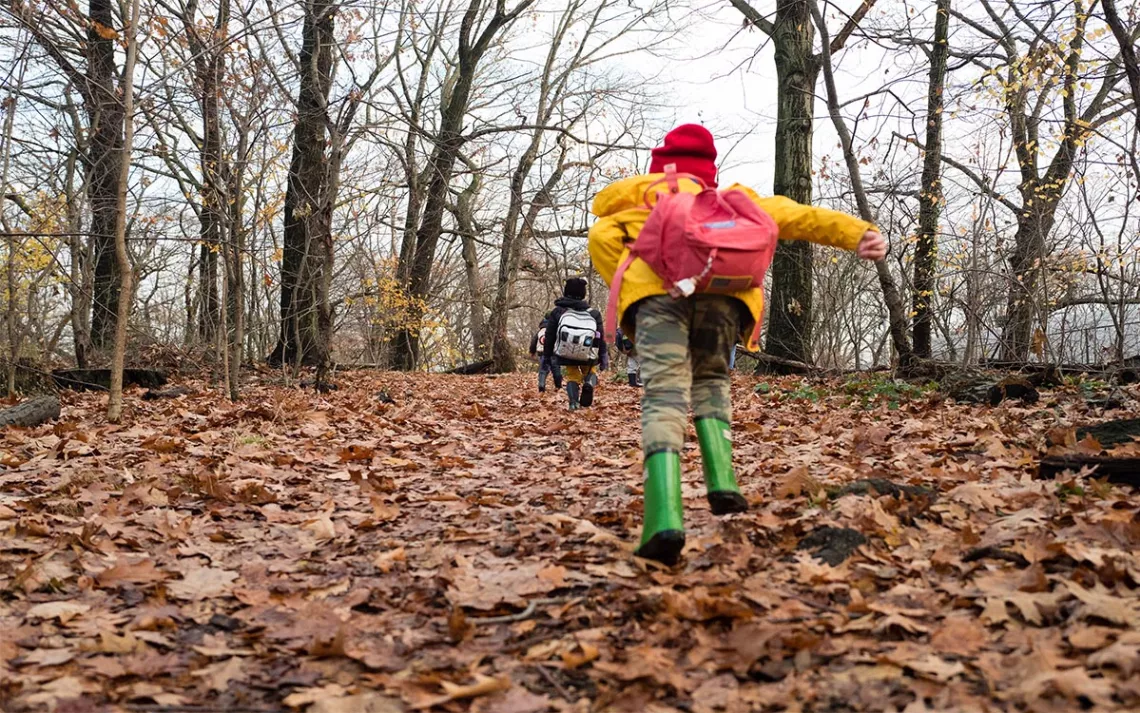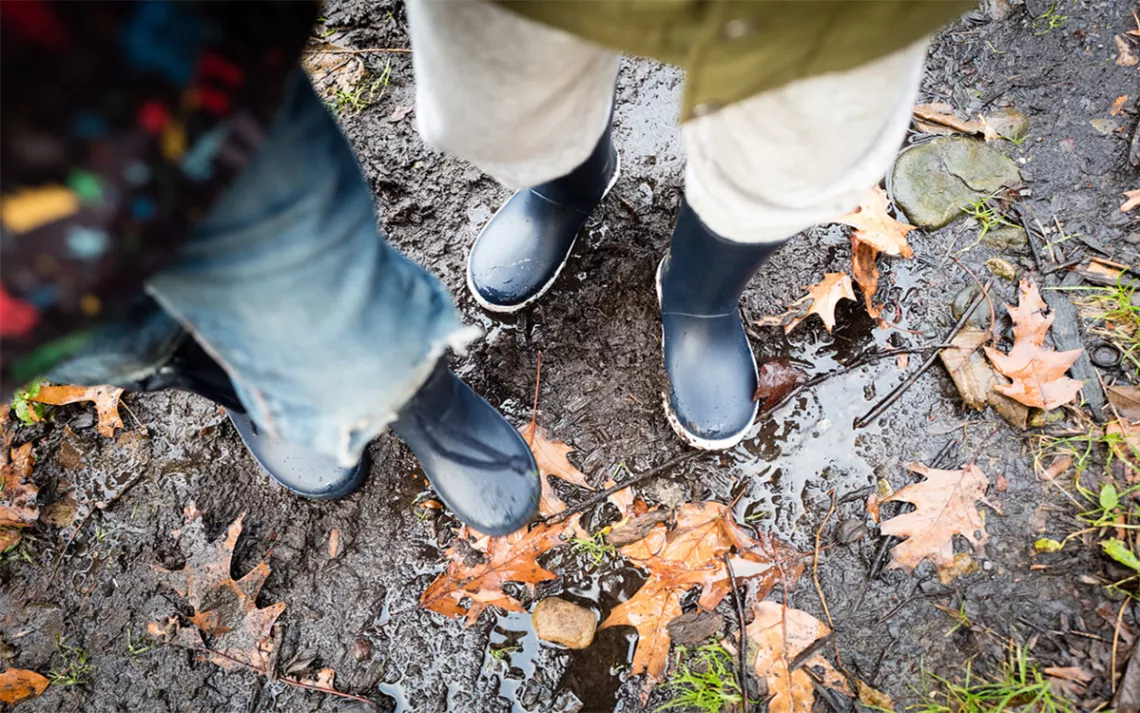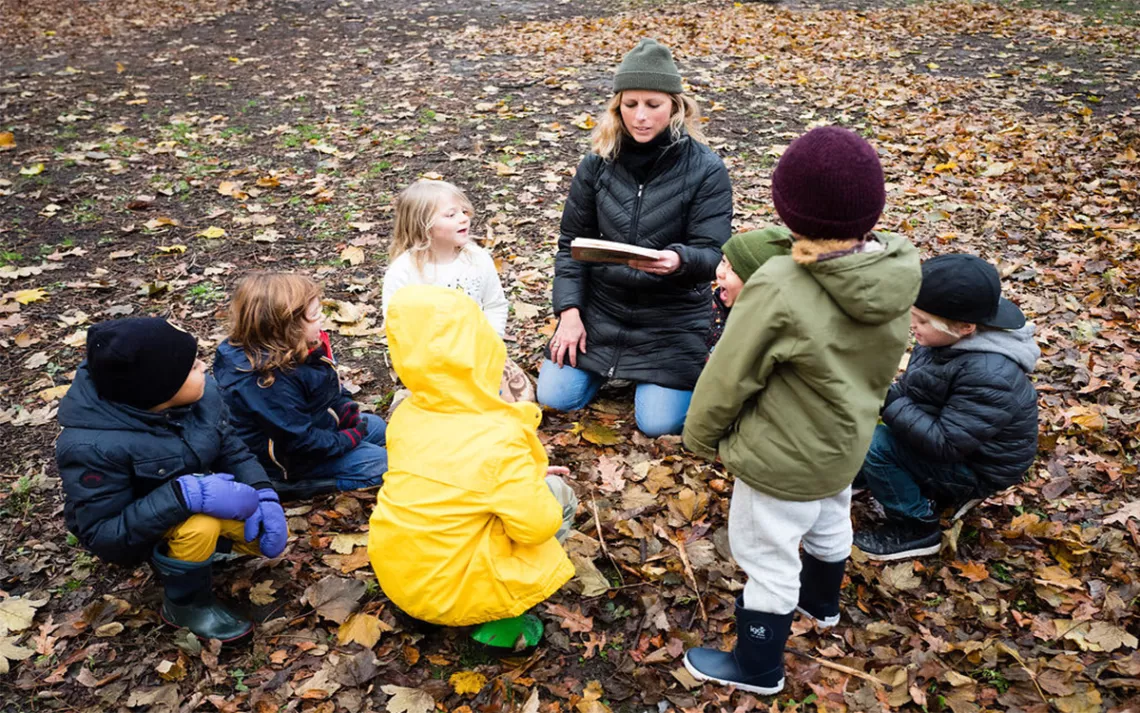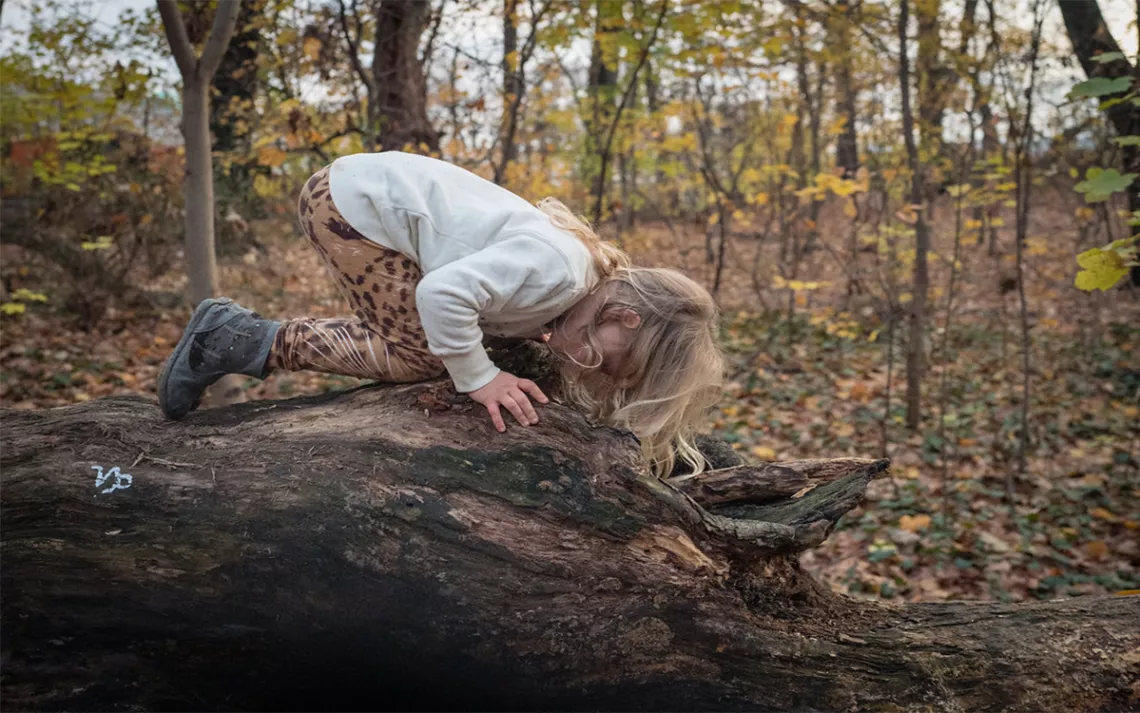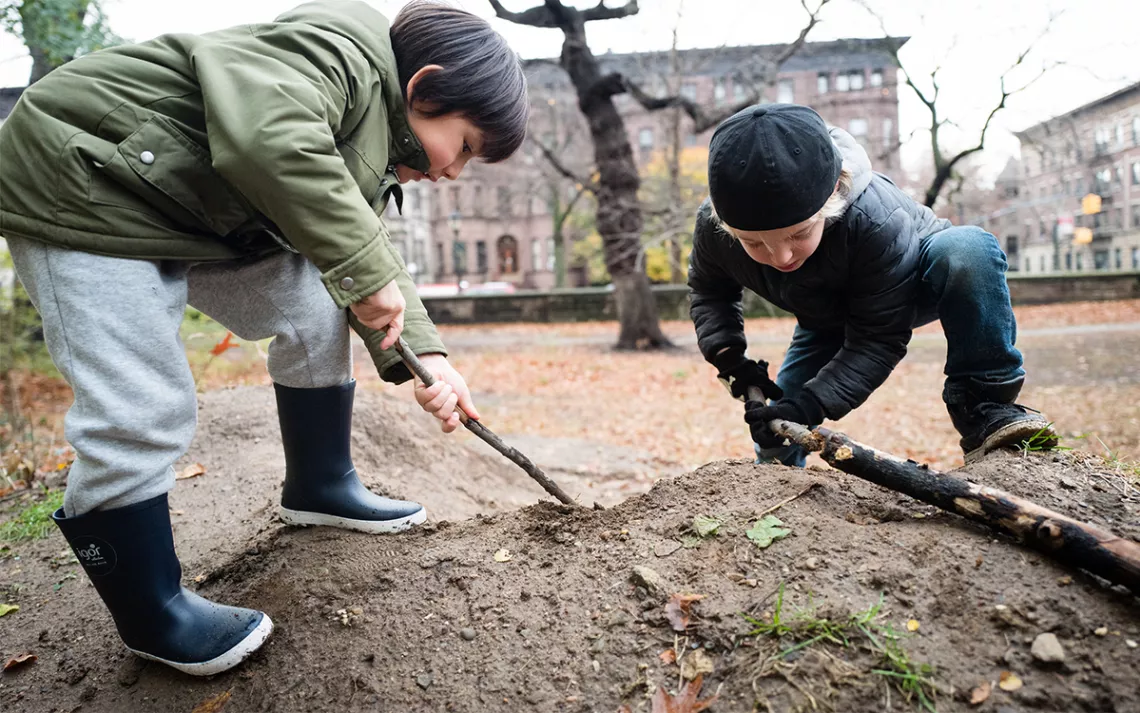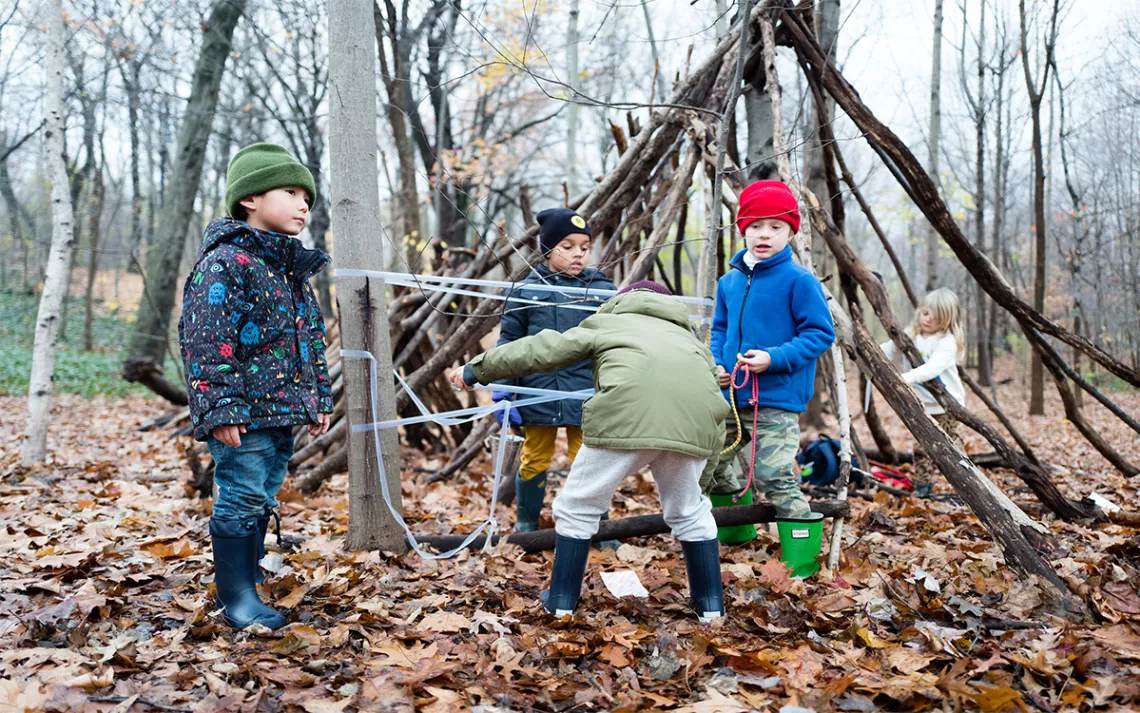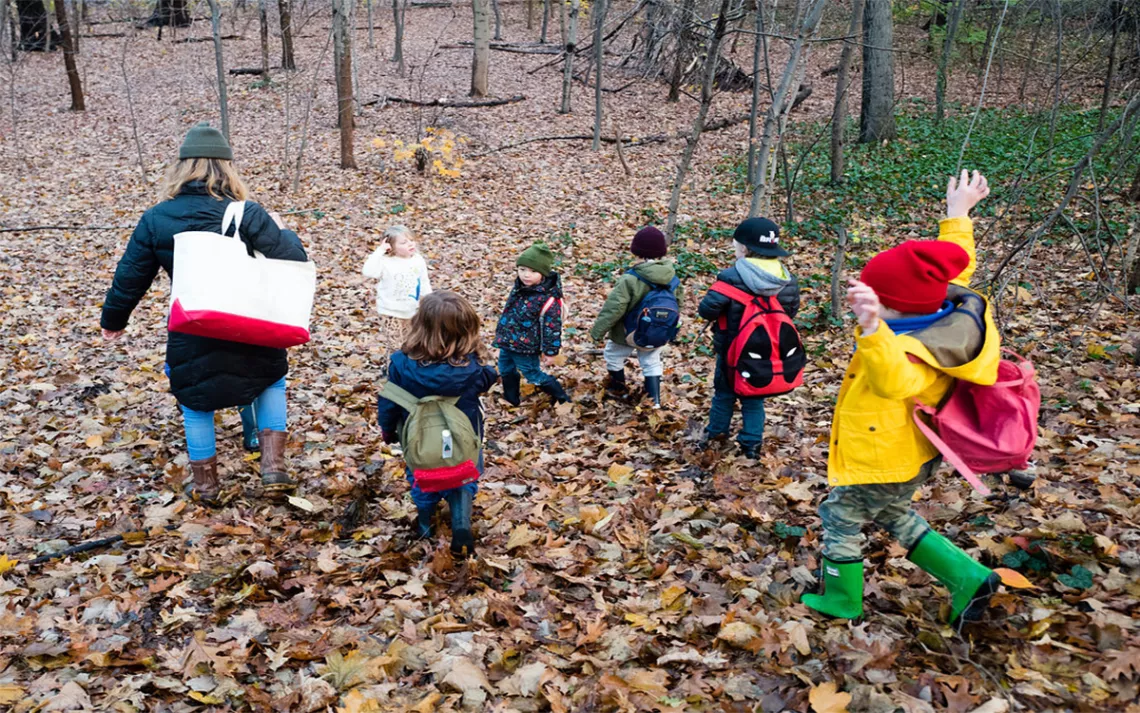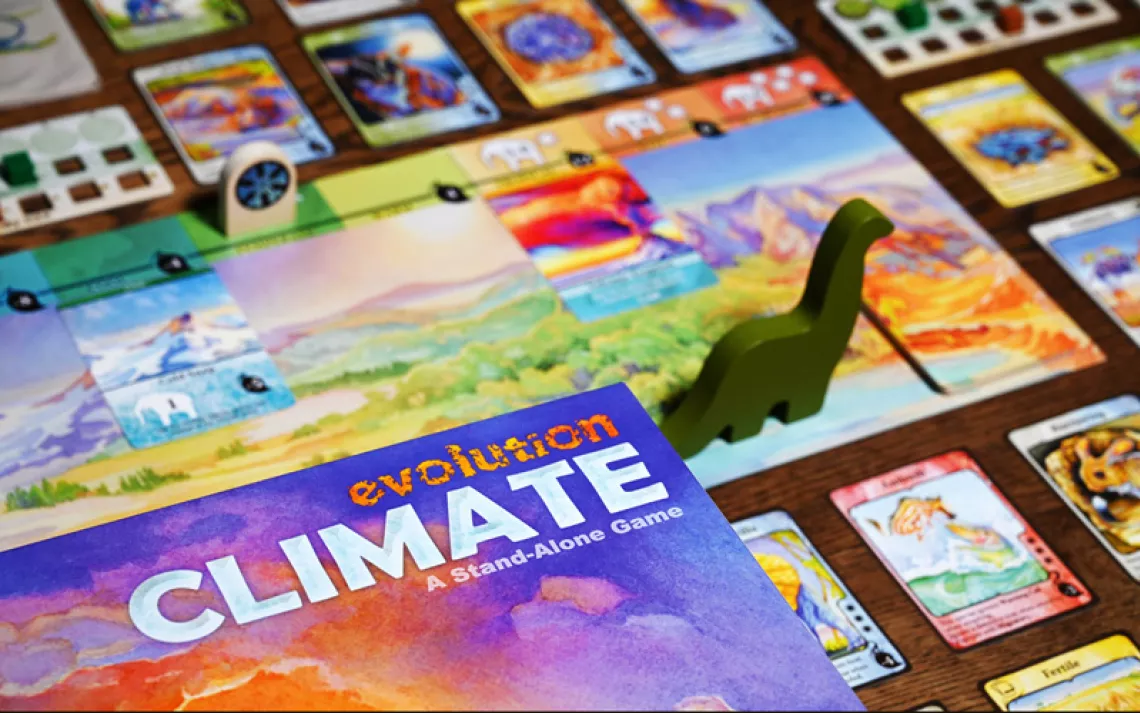ENVIRONMENT EXPLAINED
Naturally Curious Introduces City Kids to the Great Outdoors
Unstructured outdoor play is key to developing minds
Photos courtesy of Torz Dallison Photography
Where can children in New York City find a little taste of the great outdoors? It’s not that easy when you live in a giant maze of concrete and steel, where gridlocked drivers riding their horns are often the wildest species around. One Brooklyn educator, Alicia Rose Tait Hedgecoth, decided to find a way to do it, and she didn’t look much further than the wilds of Park Slope.
In 2015, Hedgecoth founded Naturally Curious Nature Walks to promote social and emotional growth, physical confidence, and creativity through outdoor adventure and play. She named her after-school program the “Mini Muirs.”
“Children flourish when given the time and space to explore and play outside,” she says. “Unfortunately, daily schedules of classes, music lessons, coordinated play dates, and appointments don’t allow for much unstructured outdoor play.”
Working with children over an extended period of time, Hedgecoth saw behavioral patterns emerge and shifted her teaching methods to meet their needs and interests. She noticed that children were more engaged when they were outside, following their own curiosity. This confirmed everything she had been reading for more than a decade on the benefits of outdoor play.
“No one specific study struck me the most. It's more like a sea of evidence you can bathe in all day,” she says. Much of her eye-opening inspiration came from reading Richard Louv’s ground-breaking book Last Child in the Woods (2005), in which he coined the term Nature Deficit Disorder to describe the link between the shortage of outdoor experiences in today's youth with obesity, depression, and attention disorders. She also read Scott Sampson’s How to Raise a Wild Child (2015). The books, in addition to other studies she read, inspired her to create the hands-on, outdoor learning experiences that led to Naturally Curious.
“A student that would be considered disruptive in a formal classroom setting would be the leader in discovering snails outside, boosting his confidence and creating a positive relationship with learning," Hedgecoth says. "Outdoors, there is no academic hierarchy that sometimes develops in a classroom setting. It doesn't matter if you are the best at multiplication or if you are reading at a lower level than your friends, when you are building a fort, digging for earthworms, or observing a hawk high in a tree. That feels good to me as an educator and I can see it feels good for the children.”
Hedgecoth began deconstructing play-based activities into their educational components: Constructing a fort builds both fine and gross motor skills, boosts communication skills (you have to talk with the people you are working with about collecting materials, placement of the branches, and the architectural plans), develops spatial awareness, tests children's understanding of basic measurement (weight, length, width, etc.), and enhances both individual and group problem-solving methods.
Hedgecoth’s mission is ambitious, considering her participants’ age and maturity: full immersion into nature, letting the kids take the lead based on their interests, hands-on exploration, and modeling good behavior in the outdoors.
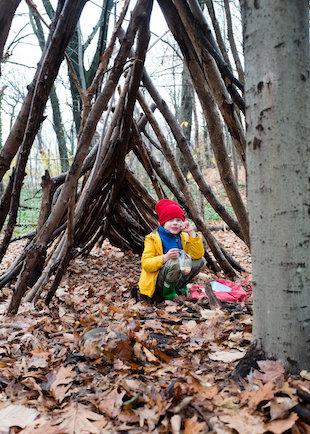 The Mini Muirs is a small enterprise, focusing on introducing four-to-nine-year-old city kids to Prospect Park in groups of 10 at a time. Meeting every week for three months, they see variations in the weather and the condition of the earth. They observe particular trees over time and draw or describe changes in their journals. Working together, the Mini Muirs accomplish goals as basic as helping each other carry a long, heavy stick over a field and through the woods.
The Mini Muirs is a small enterprise, focusing on introducing four-to-nine-year-old city kids to Prospect Park in groups of 10 at a time. Meeting every week for three months, they see variations in the weather and the condition of the earth. They observe particular trees over time and draw or describe changes in their journals. Working together, the Mini Muirs accomplish goals as basic as helping each other carry a long, heavy stick over a field and through the woods.
Children learn to persevere as they work together to build a fort with only the supplies they find in the area. They decide as a team what they want to do and execute tasks to get a job done. These young children learn to talk things out, negotiating and compromising each time they meet, hoping to convince the others to do what they would like to do. Emotionally, they become more grounded and empathetic. This week, you lead; next week, you might have to follow.
Every two-hour session begins with a John Muir reading. His adventures, rebellious nature, childlike curiosity, and mountain-man lifestyle have great appeal. No bed is necessary for a Muir-style nap; you can just lie down in a pile of leaves.
For the readings, Hedgecoth draws from multiple collections of Muir's writings and from the Sierra Club website. As conservation and outdoor education have become more of a hot topic for children and families, many children's books have been written about John Muir's life. This makes stories from his journals and publications more accessible to the four-to-nine-year-olds she teaches. The children imagine him quietly observing creatures in the forests, sketching and writing in his nature journal, just like they do.
One recent afternoon’s quote was chosen to inspire discussion on migration and local bird appreciation before doing a bird tally as they explored the woods with binoculars:
The water ouzel, in his rocky home amid foaming waters. How romantic and beautiful is the life of this brave singer on the wild mountain streams, building his round bossy nest of moss by the side of a rapid or fall, where it is sprinkled and kept fresh and green by the spray! No wonder he sings well, since all the air about him is music; every breath he draws is part of a song, and he gets his first music lessons before he is born; for the eggs vibrate in time with the tones of the waterfalls. Bird and stream are inseparable, songful and wild, gentle and strong—the bird ever in danger in the midst of the stream’s mad whirlpools, yet seemingly immortal. And so I might go on, writing words, words, words; but to what purpose? Go see him and love him, and through him as through a window look into Nature’s warm heart.
Everything the children see and feel is fodder for storytelling. An old log is a spaceship; a boulder is a meteorite. Leaves and acorns become ships in battle. Downed logs and broken branches are rearranged for optimal climbing. Dense plant growth serves as cover for hiding, and a large area of undisturbed earth is ideal for bug observation. “Bugville,” as the children affectionately call it, is one of their favorite corners. They enjoy visiting the same spots over and over.
When Hedgecoth removed some weak branches one afternoon from a fort the kids built, they got upset. She explained that to build something bigger and stronger, you have to remove crumbling parts. Once they understood, they got into it and new construction began. Encouraging independence and teamwork, she instructs them to call on her for help as a last resort, saying, “Ask three, then me.”
It’s not all natural out there in the park. They come upon man-made surprises. A broken mirror laid out on a rock in an interesting arrangement reflects the trees as well as the children’s faces. Trash is a not uncommon discovery. They remove the litter and learn why it’s important to not pollute the wild places around us.
Every excursion ends with a journaling session inspired by a prompt, such as, "What might happen if our current president had a chance to spend time in the wilderness with an inspiring naturalist?"
Donald Trump, and all of us for that matter, would do well to set Twitter aside for an afternoon and learn the answer for ourselves.
DIY Nature Walks
Don’t be intimidated if you can’t identity most trees, plants, or birds. Just take a plain old nature walk, with no destination or purpose in mind. Hedgecoth’s recommendation is to learn along with your child, and have fun. Here are a few of her tips:
- Investigate a small patch of earth with your child. Observe quietly for at least two minutes before moving the soil or digging to explore further. Can you and your child create a story based on what you are seeing? Sketch it? Journal? A child who can’t write yet can dictate a story or journal type entry to the parent. Or just talk about it.
- Create a sensory map of your neighborhood. What corner has the sweetest smelling flowers? The smelliest trash? An unusual tree? Uneven sidewalk?
- Take a slow, short, sensory walk. Let your child's curiosity lead you. When they stop to examine something or focus on an area, let them take the time they need. A short sensory walk can be a great way to calm a child that is upset or anxious. Invite them to describe one thing they can see, hear, touch, and smell.
- Meet one tree a day for a week. Discuss why this tree is important to your street or neighborhood and then thank the tree for its hard work. If you really become tree lovers, you can start a tree journal with pressed leaves, bark rubbings, written observations, and sketches of your favorite street trees, day by day, season after season.
- Take one walk each day with your child for a week. That's it. It can be a 10-minute stroll or an hour-long trek through the neighborhood or into a park. No destination. No phone calls or texts. No running errands. Walk slowly, chatting about the day, observing the world around you. Create a new family tradition that connects you to your neighborhood, your natural landscape and each other.
 The Magazine of The Sierra Club
The Magazine of The Sierra Club
